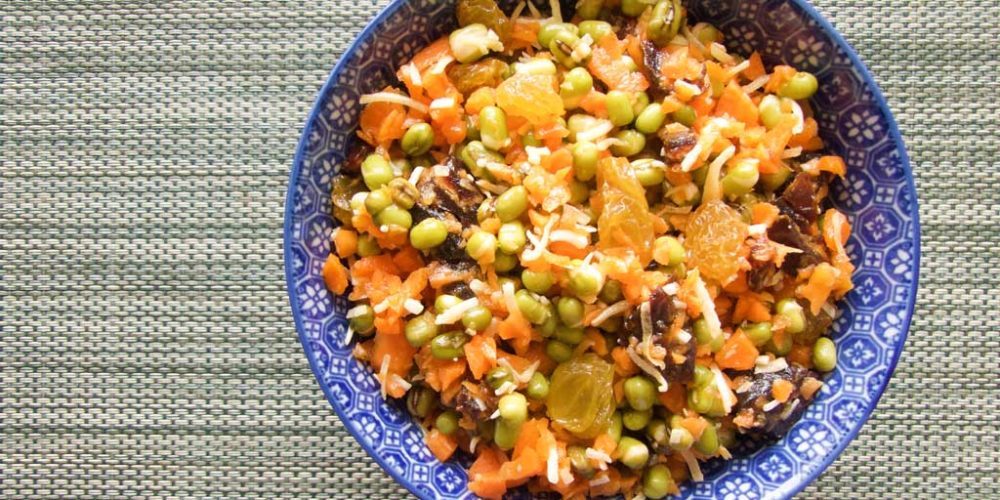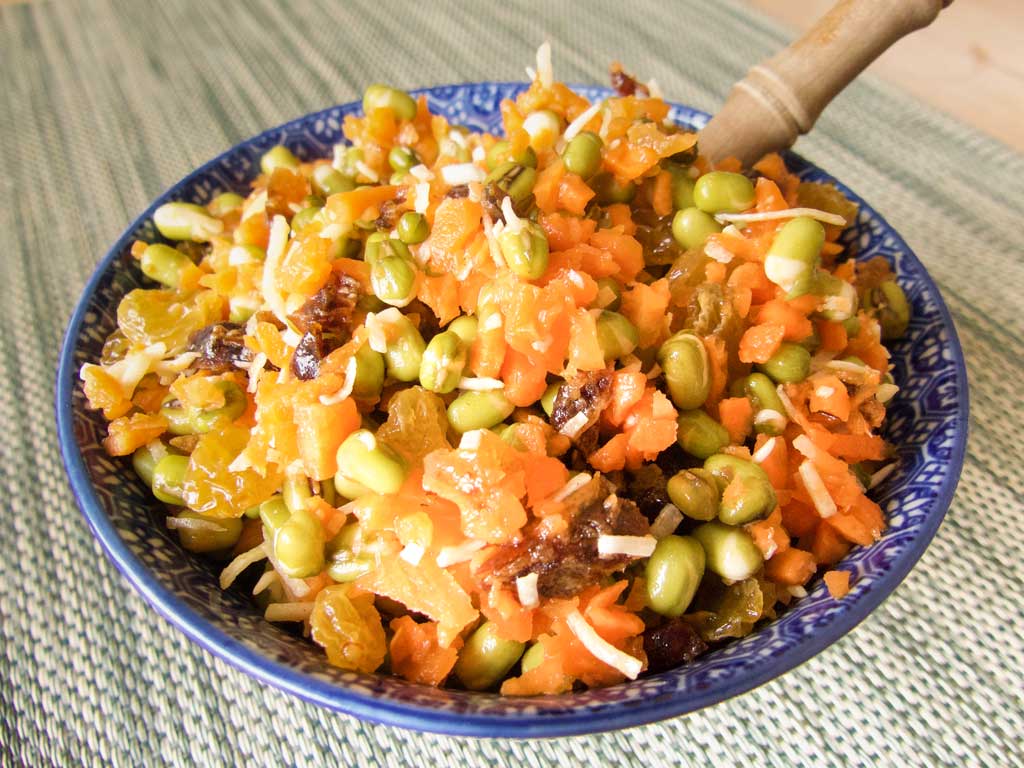Isha’s Green Gram Sprout Salad is loaded with nutrition and energy. Sadhguru says that, “when one thinks about food sources, and getting the most bang for your nutritional buck, there’s nothing more concentrated than nuts, legumes and seeds because they contain everything needed to become a healthy, vibrant plant.”
Isha fills their menus at workshops and courses—in India and around the world—with the highest quality ingredients prepared in delicious ways. There’s almost always something sprouted.
That’s because the nutrition in seeds is most accessible just at the point of changing from a dormant plant to a living, growing one. Sprouting is a way to release the vitality contained in a plant and maximize its nutritional value. When you eat a diet aimed at improving your prana (energy), you can see why sprouts become essential.
Personal sprouting trials
The first time I sprouted moong beans it did not go well. I was volunteering for an Isha Inner Engineering retreat in Calgary and sprouting was my job!
It was in the middle of the coldest and longest winter on record and the moong beans just DID NOT sprout. It was like they knew our weather and refused to come out. I felt quite bad. But, we still served them.
They were soft and they tasted fine. I wonder in hindsight if the participants all went home with “excess gas” that day (see tips below). Fortunately, I got much better at sprouting with practice.
It also helps that for home recipes I’m usually only sprouting one cup. For Isha retreats we need eight kilograms!
Isha’s Green Gram Salad has become a favourite as I increase the pranic foods in my diet. I hope you enjoy both the original recipe below and the variations we include. Happy sprouting.
Sprouting Tips
Here are the best tips for sprouting from A Taste of Well-Being – Sadhguru’s Insights for Your Gastronomics.
- Almost any nut, seed, legume or grain can be sprouted. But, not all are easily digested in a raw state.
- Even if you cook them after sprouting, the nutritional accessibility is increased by sprouting. Cooking time is also decreased.
- Chana need to be parboiled before sprouting. Otherwise, they are too hard to digest.
- Check the edibility of seeds, nuts or legumes before sprouting them. Some (in the nightshade family especially) are toxic if consumed sprouted.
- Sprouting may take a few attempts to find the right moisture, temperature and air circulation as each home has a different environment. For example, Karen lives near Canada’s Rocky Mountains in a semi-arid high altitude DRY climate. Sprouting definitely take longer in Calgary then they do in warm, humid South India.
- Use warm (not hot) water for rinsing beans and seeds.
- Keep the beans tightly bundled to retain heat for the sprouting process.
- Fresh dried beans will produce a greater number of sprouts and less “crunchy” duds.
- Experiment with your sprouting locations. Sometimes sprouts need a little air to get them going.
- Keep your tea towel moist and don’t check them too often. Sprouting times will vary.
- Sprout tails are a measure of their digestibility. Tails that are too short (under a quarter inch) or too long (over three-quarters inch) are likely to produce excess gas. You are better off to cook them than eat them raw.
Green Gram Salad sprouting instructions:
- Measure the amount of moong beans needed for a recipe (generally 1 cup of dried beans yields 6 – 8 servings).
- Spread them on a baking sheet and pick them over to remove any discoloured ones or any debris.
- Place the good beans in a glass or stainless steel bowl and rinse them repeatedly with warm water until the water runs clear when drained.
- Cover the beans with fresh warm water, so the depth of the water is twice that of the beans.
- Cover the bowl with a plate, lid or tea towel and soak overnight or for at least 6 to 8 hours. The dal is ready to sprout when the beans plump up to double or triple in size and the green skins just begin to split. Small white tails may also be visible at this point.
- Drain off the excess liquid.
- Place the wet beans in a tea towel and tie up the end in a tight bundle. The beans need to be in a compact environment in order to sprout.
- Place the bundle in a colander, and place the colander in a dark, warm environment such as a cooled oven or pantry closet for another 8 hours – with as little disturbance as possible.
- Check the progress of the sprouting after the 8 hours. When the beans produce sprouts that are around a quarter to half inch in length, the sprouts are done.
- Rinse them and pick through them again to remove any “duds” that did not sprout. Serve immediately in the dish you’ve sprouted them for.
Note: We are grateful to Isha Yoga Center for sharing this recipe for Green Gram Sprout Salad. If you enjoy this recipe, check out the other Isha recipes including Sāmbhar Sadham, Coconut Mango Crisp, Coconut Buns and Sukku Coffee.


